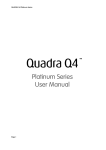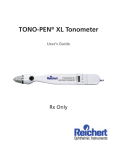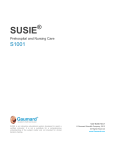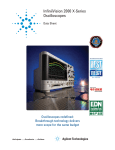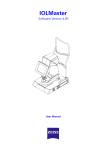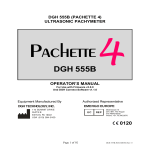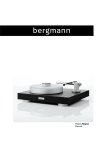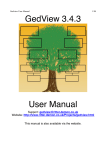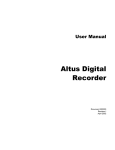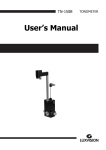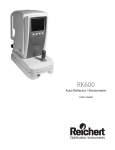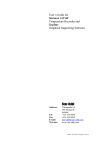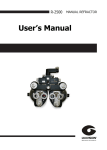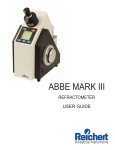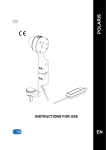Download User`s Guide
Transcript
13880-101 Rev. E 1 ©2010 Reichert, Inc. Reichert and Ocular Response Analyzer are registered trademarks of Reichert, Inc. The information contained in this document was accurate at time of publication. Specifications subject to change without notice. Reichert, Inc. reserves the right to make changes in the product described in this manual without notice and without incorporating those changes in any products already sold. Federal law restricts this device to sale by or on the order of a physician. The analysis tab of Ocular Response Analyzer version 3.0 software contains features that have not yet been cleared by the US FDA. Access to these features cannot be provided to users in the USA. ISO 9001/13485 Certified – Reichert products are designed and manufactured under quality processes meeting ISO 9001/13485 requirements. No part of this publication may be reproduced, stored in a retrieval system, or transmitted in any form or by any means, electronic, mechanical, recording, or otherwise, without the prior written permission of Reichert, Inc. 2 13880-101 Rev. E Table of Contents Preliminary Information Table of Contents Warnings and Cautions Introduction Indications for Use 3 5 6 6 Unpacking and Preparing for Use Unpacking and Contents Disengage Travel-Lock Application of Input Power Engaging the Travel-Lock 7 7 7 7 Features and Connections System Part Identification 8 Setup and Installation Setup and PC Connection System Configuration Software Installation Installation Wizard Installation Folder User Information 9 9 9 9 10 10 Getting Started/Software Overview Using the Software Initial Screen Control Icons (Buttons) and File Menu Functions 11 11 11 System Options System Options General Tab General Tab: Database Location & Database Backup System Setup Tab Information Tab Views Layout Tab Views Tables Options Views Tables Window 12 12 12 13 13 14 14 14 Demonstrating the Air Puff 15 Demo Puff Taking Patient Measurements Inititating a Measurement Normal Measurement Mode: Patient Selection Window New Patient Data Entry Window Patient Positioning Measurement Window Making Measurements The First Measurement Taking Multiple Measurements on the Same Eye Measuring the Second Eye Second Eye, First Measurement 16 16 17 18 18 18 19 19 19 Viewing Patient Measurement Data 20 20 13880-101 Rev. E Results Tab Printing Results 16 3 Table of Contents (continued) Viewing Patient Measurement Data Features & Functions of the View Measurements Window 20 (continued) Single Overlay Mode 22 Sequential Signal Mode 22 History Tab 23 Analyzing Population Data 23 View Statistics Window 23 Activating the Analysis Tab 24 Analysis Tab 24 Waveform Parameter Deviation From Mean 26 Keratoconus Match Index (KMI) 26 Keratoconus Match Probabilities 26 Printing Measurement Data Printing Measurement Data Review Window with Print Dialog Box Sample Print Out 27 27 27 Export Function Exportng Patient Data Export Wizard Export Wizard: Select Patient Export Wizard: Select Data Export Wizard: Select Destination 28 28 28 29 29 Components of the Waveform Ocular Response Analyzer Waveforms 30 Cleaning and Maintenance Fuse Replacement External Cleaning Including LCD, Housing and Buttons Forehead Rest and Patient Contact Area Cleaning Forehead Rest Pad Replacement Air Tube Cleaning Positioning and Applanation Window Cleaning 31 31 31 31 31 31 Troubleshooting Will Not Turn On or Respond Will Not Find Eye Able to Measure One Eye, But Not the Other Attempts to Align But Will Not Take Measurement Frequent Questionable Signals and/or Atypical Measurement Results Disengage Travel-Lock Error Message Shown On Software Error Message and Error Codes 32 32 32 32 Appendix Specifications Disposal Classifications EMI/EMC Compliance Guidance Tables Symbol Information Reichert Warranty 4 32 32 32 33 33 34 34 35 39 40 13880-101 Rev. E Warnings and Cautions WARNING: AN INSTRUCTION THAT DRAWS ATTENTION TO RISK OF INJURY OR DEATH. WARNING: USE OF THE OCULAR RESPONSE ANALYZER IS CONTRAINDICATED IN INSTANCES OF: - ULCERATED CORNEAS - FOLLOWING KERATOPLASTY - FOLLOWING PENETRATING TRAUMA WARNING: THE OCULAR RESPONSE ANALYZER SHOULD BE USED IN STRICT ACCORDANCE WITH THE INSTRUCTIONS OUTLINED IN THIS USER’S GUIDE. THE SAFETY OF THE OPERATOR AND THE PERFORMANCE OF THE INSTRUMENT CANNOT BE GUARANTEED IF USED IN A MANNER NOT SPECIFIED BY REICHERT, INC. WARNING: IN ORDER TO ENSURE THAT CORRECT OPERATION OF THE INSTRUMENT IS MAINTAINED, AND TO GUARANTEE THE SAFETY AND RELIABILITY OF THE INSTRUMENT, ANY REPAIR OR SERVICE MUST BE PERFORMED BY REICHERT, INC. OR AN AUTHORIZED SERVICE AGENT OF REICHERT, INC. WARNING: THE INSTRUMENT MUST BE PLUGGED INTO AN OUTLET WITH AN EARTH GROUND. DO NOT REMOVE OR DEFEAT THE EARTH GROUND CONNECTION ON THE OCULAR RESPONSE ANALYZER POWER INPUT CONNECTOR OR THE UNIT’S POWER CORD OR DAMAGE TO THE OCULAR RESPONSE ANALYZER AND/OR INJURY TO THE OPERATOR OR PATIENT MAY OCCUR. WARNING: THE AREA SURROUNDING THE OCULAR RESPONSE ANALYZER NOSEPIECE MAY CREATE A “PINCH HAZARD”. DO NOT PLACE FINGERS INTO THE OPENING SURROUNDING THE NOSEPIECE. WARNING: THE USE OF ACCESSORIES OR CABLES OTHER THAN THOSE SPECIFIED, WITH THE EXCEPTION OF THOSE SOLD BY THE MANUFACTURER AS REPLACEMENT PARTS FOR INTERNAL COMPONENTS, MAY RESULT IN INCREASED EMISSIONS OR DECREASED IMMUNITY OF THE EQUIPMENT OR SYSTEM. WARNING: THE EQUIPMENT OR SYSTEM SHOULD NOT BE USED ADJACENT TO OR STACKED WITH OTHER EQUIPMENT AND THAT IF ADJACENT OR STACKED USE IS NECESSARY, THE EQUIPMENT OR SYSTEM SHOULD BE OBSERVED TO VERIFY NORMAL OPERATION IN THE CONFIGURATION IN WHICH IT WILL BE USED. CAUTION: AN INSTRUCTION THAT DRAWS ATTENTION TO THE RISK OF DAMAGE TO THE PRODUCT. CAUTION: THE INTERNAL CIRCUITRY OF THE INSTRUMENT CONTAINS ELECTROSTATIC DISCHARGE SENSITIVE DEVICES (ESDS) THAT MAY BE SENSITIVE TO STATIC CHARGES PRODUCED BY THE HUMAN BODY. DO NOT REMOVE THE COVER OF THE OCULAR RESPONSE ANALYZER WITHOUT TAKING PROPER PRECAUTIONS OR DAMAGE TO THE INSTRUMENT MAY OCCUR. CAUTION: DO NOT USE SOLVENTS OR STRONG CLEANING SOLUTIONS ON ANY PART OF THE INSTRUMENT OR DAMAGE TO THE UNIT MAY OCCUR. SEE THE MAINTENANCE SECTION FOR DETAILED CLEANING INSTRUCTIONS. CAUTION: this instrument is not suitable for use in the presence of flammable anesthetic mixtures such as oxygen or nitrous oxide. CAUTION: mEDICAL ELECTRONIc EQUIPMENT NEEDS SPECIAL PRECAUTIONS REGARDING EMC AND NEEDS TO BE INSTALLED AND PUT INTO SERVICE ACCORDING TO THE EMC infoMATION PROVIDED IN THE ACCOMPANYING DOCUMENTS. CAUTION: PORTABLE AND MOBILE RF COMMUNICATIONS EQUIPMENT CAN AFFECT MEDICAL ELECTRICAL EQUIPMENT. CAUTION: This instrument is not to be used NEAR high-frequency EMITTING surgical equipment. 13880-101 Rev. E 5 Introduction Congratulations on your purchase of the Ocular Response Analyzer. The Ocular Response Analyzer is a revolutionary instrument designed to measure the intraocular pressure of the eye and biomechanical properties of the cornea in one simple, fast measurement. The instrument has an innovative automatic alignment system that eliminates operator subjectivity and provides precise, repeatable measurements. This User’s Guide is designed as a training and reference manual for operation, maintenance, and troubleshooting. We recommend that you read it carefully prior to use and follow the instructions in the guide to ensure optimum performance of your new instrument. If used properly, the Ocular Response Analyzer will provide you with fast, accurate and reliable measurements for many years. Please retain this manual for future reference and to share with other users. Additional copies can be obtained from the Reichert Customer Service Department. Contact information is provided at the end of this guide. Indications for Use: The Ocular Response Analyzer is intended to measure the intra-ocular pressure of the eye and the biomechanical response of the cornea. 6 13880-101 Rev. E Unpacking and Preparing for Use Unpacking and Contents Great care has been taken to deliver your instrument to you. The packaging was specially designed to transport this device. Please retain the packaging for future use in case transportation is required. To remove the components: 1. 2. 3. 4. 5. Remove the top foam piece from the shipping container. Remove the accessories. Remove the upper foam piece from the Ocular Response Analyzer measurement head. Lift the unit out of the box using the handle-slots in the cardboard cradle. Unfold the cradle, remove the plastic bag from the instrument, and set the unit in a safe location. The items listed below should be included in the package. If any of these items are missing, please contact the Reichert Customer Service Department. Contact information can be found on the back page. • • • • • Ocular Response Analyzer Measurement Head Dust Cover Phillips Screw Driver Power Cord User’s Guide NOTE: All parts of this system are suitable for use in the patient environment. Place the unit on an adjustable height instrument stand in a clean, dry, temperature controlled environment (50 110° F / 10 - 43° C). Keep away from direct sunlight, bright lights, and Infrared (IR) light-generating devices. Disengage Travel-Lock The Ocular Response Analyzer’s automatic alignment system utilizes sophisticated electronic motors. To ensure that the motors are not damaged during shipment, the instrument features a Travel-Lock to hold the components securely in place. 1. 2. 3. Locate the travel-lock-screw access hole in the back cover of the instrument (see page 8). Insert the Phillips screwdriver into the travel-lock hole and feel for engagement with the screw. Turn the screw counterclockwise at least six full turns (the screw remains inside the travel lock hole). NOTE: It is very important to disengage the Travel-Lock before applying power to the Measurement Head. Application of Input Power 1.Insert the female end of the power cord into the power input receptacle located on the side of the instrument near the bottom (see page 8). 2.Plug the male end of the power cord into a wall outlet of the appropriate voltage. Input voltage must not exceed the range specified on the instrument data plate. An appropriate wall socket adapter may be required depending on your wall-outlet style. Engaging the Travel-Lock (To be performed only when shipment of the instrument is required.) Before shipping the unit for any reason, the instrument must be parked and the Travel-Lock must be engaged. 1. Click the Park button found on the System Setup Tab of the Tools/Options Menu (see page 13). The software will display a message when the head is “parked.” 2. Locate the travel-lock-screw access hole in the back cover of the instrument (see page 8). 3. Insert the Phillips screwdriver into the travel-lock hole until contact with the screw is made (see page 8). 4. Push the screw inward, compressing the retainer spring, and turn the screw clockwise until tight. Failure to engage the Travel-Lock prior to shipment may result in damage to the unit and may void the warranty. 13880-101 Rev. E 7 Features and Connections System Part Identification 1. 2. 3. 4. 5. 6. 7. 8. 9. Forehead Rest: Comfortable left/right sliding headrest used for patient positioning and stabilization. Nosepiece: Air tube where “air puff” originates. Green LED patient fixation target is visible inside this tube. Canthus Marks: Alignment marks for proper positioning of instrument-to-patient-eye height. Travel Lock: Locking mechanism that protects internal components during shipment. Power Indicator: Blue LED indicates measurement head is turned ON. Communication Port: RS-232C port for connection to system PC. On / Off Switch: Rocker-switch used to turn the instrument on and off. The “up” position (_) is on. Power Input Receptacle and Fuse Holder: Input for AC power cord and location of fuses. Computer Connection: RS232 serial cable connection on PC. 1 2 3 4 5 Travel-Lock & Power Light Patient Interface 6 7 8 9 Connections & Power 8 PC Connection A typical PC is shown here. Not all PC’s will be the same. USB or PCMCIA adapters can be used on computers that do not have a serial port. 13880-101 Rev. E Setup and Installation Setup and PC Connection The Ocular Response Analyzer must be set on an adjustable height instrument stand and connected to a PC. The system is sold in various configurations, so these items may need to be obtained independently if they were not provided with the instrument. NOTE: It is essential to disengage the Travel-Lock before turning the instrument on. See page 7 for instructions. System Configuration Software Installation The installation shown on the left shows the patient side of the instrument facing the same direction as the operator interface. This enables the system to be positioned close to a wall, conserving space. It also allows operators to directly observe instrument / patient alignment. Alternate configurations are possible, depending on the needs of the operator. Connect the RS232 cable from the COM port on the instrument to the serial input on the computer. USB-serial or PCMCIA adapters may be used for computers that do not have a serial port. Use the Windows control panel to identify the COM port that a serial adapter is installed on, then set the ORA software to the same COM port using the Tool/Options/System Setup settings. Turn on the computer and insert the provided Ocular Response Analyzer software CD. The software will automatically run and guide the operator through the installation process. Installation Wizard Once the software installation process has begun, a dialogue box will appear asking if your Ocular Response Analyzer features a built-in ultrasound pachymeter. Click YES if your instrument features a 20 MHz ultrasound pachymeter (units produced prior to 2009). Click NO if your unit does not have a pachymeter. 2 13880-101 Rev. E NOTE: For Pachymeter operating instructions please see the 13880-101 Rev B user manual. Please contact Reichert for a copy of the 13880-101 Rev B user manual. Contact information is located on the back cover of this manual. 9 Setup and Installation (continued) Installation Folder: The software will be installed on the computer in the following location unless otherwise specified by the operator: C:\Program Files\Reichert\ORA User Information: A User Name and Company Name must be entered. For Example: User Name: Dr. William Jones Company Name: Better Vision Center This information will be archived along with patient measurement data and will appear on the measurement result print out. Once the software is installed, an icon like the one shown on the left will appear on the PC desktop. Double click the icon to begin using the software. 10 13880-101 Rev. E Getting Started / Software Overview Using the Software The Ocular Response Analyzer PC software package controls the functions of the measurement head and allows for archiving of measurement data. There are text menus and icon-based buttons, many of which perform the same tasks, to suit different user preferences. Initial Screen Control Menus Control Icons Workspace Status Display Control Icons (Buttons) and File Menu Functions File Menu: Click the File Menu items or Control Icons to access the following modes or functions: Measure (Quick or Normal): Quick mode can be accessed by clicking the small arrow immediately to the right of the Measure Icon. This mode enables operators to proceed immediately to the measure screen without entering patient information into the database. Results can be archived after measurements are obtained. Normal mode requires operators to enter patient information before proceeding to the measure screen. All measurement data taken in Normal mode will be archived into the database. Open: Enter this mode to examine existing patient data for on-screen review or printing. Print: Enables printing of patient data on optional color printer. Exit: Click to close the software. View Menu: Click the View Menu to access the following functions: Tables: Enables operators to edit database groups and races. Statistics: Click to view population data by group, race, and sex for all patients in an existing database. Tools Menu: Click the Tools Menu to access the following function: Demo Puff: Enables operators to demonstrate the air-puff to patients before beginning an exam. Export: Enables export of patient data for use in other applications such as spreadsheets or databases. Options: Enables operators to modify various system settings. Window Menu: Click to cascade or tile multiple windows. Help Menu: Contains information about the Ocular Response Analyzer software package. 13880-101 Rev. E 11 System Options System Options To modify system settings, click on the Tools Menu and select Options. There are four tabs containing various system setting options. General Tab The General Tab on the Options Window provides settings for a number of features: The maximum number of measurements per eye can be set (maximum of four). The Ocular Response Analyzer uses a mathematical signal filter to calculate IOPg, IOPcc, CH, and CRF values from the raw measurement signal. Turn the Filtered Signal on or off by clicking the check box. To prevent accidentally closing the software, users can enable the Confirm on Exit check box at the bottom of the General Tab. The Keratoconus Match Index features can be enabled by clicking the Unlock KC Score Tool button. Details on this feature are on page 25. General Tab - Database Location and Database Backup The default database filename is ora.mdb. The default location of the database is: Windows XP: C:\Documents and Settings\All Users\Application Data\Reichert\ORA Windows Vista: C:\Users\Public\Documents\ Reichert\ORA Users can rename the database, create multiple databases, or change the location of databases if desired. Click the button to the right of the database path to select the desired database. Databases can be stored on a shared network drive and accessed from any PC with the software installed. A Backup Location for databases can be specified and the desired backup frequency can be set. 12 13880-101 Rev. E System Options (continued) System Setup Tab The System Setup Tab on the Options Window enables users to modify the following options: Communications Port This setting controls which COM port the software will use to receive data from the measurement head. RS232 serial ports are typically COM 1 or COM 2. USB to Serial adapters or PCMCIA to serial adapters will assign a COM number that is not currently in use on the PC. Use the Windows Control Panel to identify the COM port of a serial adapter device. Park Park the instrument before locking in preparation for transport. See page 7 for details on parking and locking. Information Tab The Information Tab enables users to modify the User name and Company name. This information is stored in the database and appears on the printout. 13880-101 Rev. E 13 System Options (continued) Views Layout Tab The Views Layout tab enables users to configure the headers that will be visible in the patient data window. Users should check the options that they wish to see when they are viewing, sorting, or searching the patient database. See page 16 for further information on patient information viewing and sorting. View Tables Options Click the View Menu and select Tables to add, edit, delete, or reassign the group names, race categories, and plot options utilized throughout the Ocular Response Analyzer software. View Tables Window To edit Groups and Races, select Tables from the View Menu. The View Tables Window contains two tabs: Groups, and Races. Operators may use the Add button to create additional Groups or Races. Existing Groups and Races can be edited or deleted using the respective buttons. When a Group or Race is deleted, the operator will be given the option to delete the category only, or the category and the contents. Deleting the category only enables the operator to reassign the patient data to a different category, rather than deleting the data. Operators can also use the Reassign button to reassign data from one group or race category to another. Click the Close button when finished. 14 13880-101 Rev. E Demonstrating the Air Puff Demo Puff Before measuring a patient it may be helpful for operators to demonstrate the air puff so that the patient will know what to expect. With the patient seated comfortably in front of the instrument the operator should instruct the patient to hold a hand a few inches in front of the air tube, where the red fixation lights are visible. Initiating the Demo Puff Select Demo Puff from the Tools Menu to bring up the Demo Puff Dialog Window. Click the Demo button to initiate the air puff. The button can be pressed as many times as desired. Click the Close button when finished. 13880-101 Rev. E 15 Taking Patient Measurements Initiating a Measurement There are two measurement modes: Quick and Normal. Quick Mode is accessed by clicking the Arrow next to the Measure Icon. This immediately brings up the Measurement Window, bypassing the entry of patient information. Measurements made in Quick Mode cannot be printed. However, patient information and results can be saved afterwards, allowing the device to be used as a screening instrument, but providing the flexibility to save the patient data if remarkable results are discovered. Normal Mode requires entry of patient information such as Name, Birth Date, etc. Results are archived when using Normal Mode. Click the Measure Icon to use the Normal Mode. Normal Measurement Mode: Patient Selection Window The Patient Selection Window displays the list of existing patients. Operators can sort the patient list in ascending or descending order by clicking on the headers. Visible headers can be modified in the Views Layout Tab (see page 14). Operators can also search by patient name, edit existing patient data, or merge existing patient records using the respective buttons. All patient names can be displayed at once, or a specific Group can be viewed. The Group Function is used to create separate patient data archives. New Group names can be added by clicking Add New from the Selected Group list. Click the New Patient button to enter a new patient into the database. To measure an existing patient, double click the name of the patient from the Existing Patient List. New Patient Data Entry Window After clicking the New Patient button, the New Patient window will appear. All fields indicated by an asterisk (*) are required. The software will not allow a patient birth date of the current date to be entered. The ID field automatically generates a sequential patient ID number. Patient Data Field 1 and Patient Data Field 2 are open text fields for additional identification information. Operators may press the New Patient button again to continue entering new patients into the database or highlight one of the names on the list and click Next, or double-click the name, to advance to the Measurement Mode. 16 13880-101 Rev. E Taking Patient Measurements (continued) Patient Positioning Proper patient positioning promotes fast and accurate measurements. Patients should remove contact lenses, loosen tight collars and ties, and be relaxed. Operators should inform patients that nothing will touch their eye and that they will only feel a very gentle puff of air. It may be helpful to demonstrate the air puff to patients before the exam. See page 15 for details. The Ocular Response Analyzer features a left / right sliding forehead rest that enables the software to automatically determine which eye is being measured. It must be positioned completely to one side or to the other in order to take a measurement. A properly-positioned patient will easily see the fixation cues. The fixation target is a green light, located inside the air tube, surrounded by four red LED lights. In order to take a measurement, patients must be fixating on the green light. If a patient is unable to see the green light, the operator should verify that the patient can see any of the red lights. If any red lights can be seen, the automatic alignment system will bring the green fixation target into view. Set the height of the table so the canthus marks on the sides of the instrument are level with the patient’s eyes. Patients should lean forward slightly so that the center of their forehead rests in the middle of the rubber forehead pad. The patient’s head should contact the headrest straight-on; perpendicular to the front of the instrument (not turned to the side). In addition, the patient’s nose and chin should be inward, towards the front surface of the unit. Correct Patient Positioning To ensure fast and accurate results operators should instruct the patient to blink a few times and hold both eyes open immediately before clicking the Measure Response button. Remind the patient to look directly at the green light and hold steady. Observe the photo on the left. Notice the distance between the patient’s chin and the front of the instrument. The instrument is too low, causing the patient to rest her head in a downward-facing manner. In this instance, the patient may not be able to see the fixation target, and the alignment system may not be able to find the patient’s eye. Incorrect Patient Positioning 13880-101 Rev. E 17 Taking Patient Measurements (continued) Measurement Window The Measurement Window enables operators to initiate a measurement and to see the resultant numerical data. The Measure Response button initiates automated alignment and measurement. Right Eye Data Window Right Eye Delete Data Button Left Eye Data Window Left Eye Delete Data Button Measure Response Button Measure Eye Indicator Done Button Cancel Button Making Measurements NOTE: For Pachymeter operating instructions please see the 13880-101 Rev B user manual. Please contact Reichert for a copy of the 13880-101 Rev B user manual. Contact information is located on the back cover of this manual. The position of the sliding forehead rest controls which eye will be measured. Slide the forehead fully to the left or right and position the patient properly (see the Patient Positioning section) to take a measurement. The First Measurement To take a measurement, simply click the Measure Response button. The system will automatically align to the apex of the cornea and the instrument will take a measurement. The signal will be displayed and the measurement results will appear in the right or left eye data window, depending on which eye was measured. Up to four measurements can be taken per eye. To ensure the reliability of the measurement data, operators should look at the Waveform Score (WS) on the lower right of the signal window. The waveform score is presented on a scale of zero (0) to ten (10). The higher the number, the more reliable the measurement data will be. Unreliable signals can be deleted by highlighting the desired measurement values and then clicking the delete button (x). 18 13880-101 Rev. E Taking Patient Measurements (continued) Taking Multiple Measurements on the Same Eye It is recommended that operators take multiple measurements on each eye so that the signals can be evaluated for consistency to ensure accurate results. A maximum of four signals and measurement result lines can be displayed at once. When multiple measurements are taken, the signal with the highest waveform score will automatically be selected as the signal that the final results will be based on. Operators may need to take additional measurements, deleting unacceptable signals, until acceptable results are obtained. Eyes with irregular corneas or pathology may make obtaining a reliable signal more difficult. Some eyes may never produce “normal” signals. Measuring the Second Eye After completing the number of desired measurements on the first eye, operators should slide the headrest fully to the other side and reposition the patient for measurements on the second eye. Second Eye, First Measurement Once the patient is repositioned, simply click the Measure Response button again. When the first measurement for the second eye is taken, the measurement signal will appear on the screen. Operators can click on the left or right eye data windows to switch back and forth between the signals from either eye. When the desired number of measurements has been obtained for both eyes, the operator must click the Done button to proceed to the Results Window. Done Button 13880-101 Rev. E 19 Viewing Patient Measurement Data Results Tab The Results Tab displays patient measurement data. If multiple measurements were taken, only the results from the measurements with the highest waveform score for each eye will be displayed. This window automatically appears after taking patient measurements and clicking the Done button. Operators can also access this mode by clicking the Open Icon or selecting Open from the File Menu and then choosing the patient to be reviewed. Printing Results Measurement data can also be printed using the Print button, accessible from this screen. See the Printing Patient Data section of this guide for details. 1. References 2. Measurement History 3. Waveform 4. Eye Selection 5. Plot Options / Notes Tabs 6. New Measure Button 7. Close Button Features and Functions of the View Measurements Window This screen is a powerful patient data analysis tool that displays patient data in a number of formats. Detailed descriptions of the features, functions, and buttons are provided below. 1. References: Displays measurement data corresponding to a specific measurement. Operators can click on any line in the measurement history list to view the numerical data from that measurement. The References window can be hidden by clicking on the arrow to the right of the word ‘References’. 2. Measurement History: Displays the date, time, and eye measured for historical measurements recorded for the patient. Only the measurement with the highest waveform score, from each eye, for each session, is displayed. NOTE: Measurements can be deleted by highlighting the desired line and pressing the delete key on the keyboard, or right-clicking to bring up the Delete option. Operators should be aware that deleted measurements cannot be recovered. 20 13880-101 Rev. E Viewing Patient Measurement Data (continued) Features and Functions of the View Measurements Window (continued): 3. Waveform: The waveform for the selected measurement is displayed. 4. Eye Selection Radio Buttons: These controls are activated in Sequential Mode or when viewing the History Tab when it is possible to view Left, Right, or Both eye data on the screen. 5. Plot Options Tab: On the Plot options tab, operators can select Waveform, Overlay, or Sequential mode. Waveform mode is the default view, showing the waveform from the selected measurement and the CH, CRF, IOPg and IOPcc data for this measurement in the references window. In Overlay mode, operators can view up to four signals from the same subject simultaneously superimposed over one another. See page 22 for more details. In Sequential mode, operators can select up to 10 signals for each eye on the same subject and display them in date/time sequential order. See page 22 for more details. Notes Tab: Patient exam notes (Medications, Conditions, Exam Notes #1, and Exam Notes #2) can be entered for any selected (checked) measurements. Clicking on a line in the Measurement History list will cause the corresponding measurement notes to appear. Measurement notes can be edited by clicking on the Edit Buttons to the right of the note line. 6. New Measure Button: Click to begin a new measurement session on the patient whose data was being reviewed. 7. Close Button: Click to close the View Measurement Window. 13880-101 Rev. E 21 Viewing Patient Measurement Data (continued) Signal Overlay Mode An example of four waveform signals in Overlay Mode is shown on the left. Operators must manually select signals by clicking on the desired check boxes in the measurement history list. Up to four measurements can be displayed at once. Each signal appears in a different color. The colors are automatically assigned by the software in a sequential manner, depending on the order the signals are selected in. The references for each signal are shown on the right of the Signal Overlay window. Sequential Signal Mode An example of ten measurement signals per eye in Sequential Mode is shown on the left. Operators must manually select signals by clicking on the desired check boxes in the measurement history list. Left eye signals appear in red. Right eye signals appear in blue. The signals will be displayed in date/time sequential order, regardless of the order they are selected in. 22 13880-101 Rev. E Viewing Patient Measurement Data (continued) History Tab An example of IOPcc data plotted diurnally for a patient is shown on the left. Plot Menu: Operators can select which parameter they want to review for the selected patient. Time Menus: Click the down arrow to select By Date to view all measurements taken on a specific date for a particular patient, or select Diurnal, to view serial measurements over time for a patient. When the Time List is set to Diurnal, select the Date of the measurements to be viewed from the Days menu. Rescale Button: If measurements fall outside of the default X and Y axis values, the Rescale button will change the scale so that all data points are visible. Analyzing Population Data The View Statistics Screen, accessible by clicking on the Statistics Icon or selecting Statistics from the View Menu, enables operators to analyze population trends. View Statistics Window Operators can “filter” the data to be evaluated by selecting options from the Group, Sex, Race, and Plot drop-down lists at the left hand side of the screen. Average values, standard deviation, minimum and maximum values are shown for the selected parameters. 13880-101 Rev. E 23 Viewing Patient Measurement Data (continued) Activating the Analysis Tab NOTE: New Ocular Response Analyzer systems may come pre-configured with the Analysis tab already activiated. In this case, the instructions for unlocking the analysis tab on this page can be disregarded. NOTE: The analysis tab of Ocular Response Analyzer version 3.0 software contains features that have not yet been cleared by the US FDA. Access to these features cannot be provided to users in the USA. Ocular Response Analyzer version 3.0 features an optional Analysis tab that will not appear by default. To access these features, users must contact Reichert or an authorized distributor to obtain an unlock code. To activate the analysis tab, go to the Tools menu and click on Options. On the General tab, click the Unlock KC Score Tool button. A window with an installation ID will appear. Note the Installation ID and provide this information to Reichert or to your Reichert Authorized Distributor to obtain the matching unlock code. Analysis Tab Once activated, the Analysis Tab will appear next to the Results and History tabs in the software. The data presented on this tab will only be generated for measurements taken after the installation of version 3.0 software. If you have upgraded a pre-existing system to version 3.0 software, the previously acquired data will not be retroactively updated to display the new indices provided on the analysis tab. However, all of the previous data will remain intact and will be accessible. 24 13880-101 Rev. E Viewing Patient Measurement Data (continued) Analysis Tab (continued) Each Ocular Response Analyzer measurement signal generates a total of 37 waveform parameters. These parameters are mathematical representations of waveform shape characteristics such as peak height, area, slopes, etc. Different eyes can generate sigifcantly different waveforms shapes. Eyes with certain pathologies share common waveform features. The analysis tab of Ocular Response Analyzer software version 3.0 features indices for assessing the similarity of a subject’s measurement waveform to the characteristics of waveforms from various keratoconus populations. Data from 5 reference populations are utilized in this analysis: Normal, Suspect, Mild, Moderate, and Severe keratoconus eyes. For a given measurement, each of the 42 Ocular Response Analyzer parameters (37 waveform parameters, Waveform score, CH, CRF, IOPg, IOPcc) are plotted against a normalized average value of each parameter for a normal reference population on the Waveform Parameter Deviation From Mean plot. A selected group of 7 waveform parameters are utilized to present a Keratoconus Match Index (KMI) and the Keratoconus Match Probability (KMP). These software features describe how similar the measurement in question is to Ocular Response Analyzer waveforms gathered from the reference populations. NOTE: The Ocular Response Analyzer does not diagnose disease. The KMI and KMP merely represent the similarity of Ocular Response Analyzer waveform characteristics to data from reference populations. This is not a substitue for a clinical evaluation and the opinion of experienced medical professionals. Keratoconus Match Index Keratoconus Match Probabilities Waveform Parameter Deviation From Mean 13880-101 Rev. E 25 Viewing Patient Measurement Data (continued) Waveform Parameter Deviation From Mean The Waveform Parameter Deviation from Mean plot provides a graphical representation of all Ocular Response Analyzer measurement parameters for a measurement waveform plotted against normative data. The green line down the center represents the normalized average value of each parameter for an 836 eye normal population. The dashed and solid red lines represent one and two standard deviations from the mean of the normal population respectively. By quickly glancing at this graphic, users can see if the measurement signal in question is typical of a normal eye or not. Waveform parameter data points represented in green are less than one standard deviation from the mean. Data points in yellow and red are more than one or more than two standard deviations from the mean respectively. Data points that are represented by small squares are not used in the KMI and KMP calculations. Data points represented by small circles are used in the KMI and KMP calculations. Data points displayed in black are more than six standard deviations from the mean of the normal population and are outside of the plot range. NOTE: There is no “directionality” associated with the data points on the Waveform Parameter Deviation from the Mean plot. Data points may fall above or below the green line. When there are waveform parameter data points that are more than one or two standard deviations from the mean, it does not necessarily indicate that there is something clinically “wrong” with the eye in question. It simply means that the waveform generated from that eye has characteristics that are significantly different from the average of a normal population. Keratoconus Match Index (KMI) The Keratoconus Match Index is a composite value that represents the similarity of the waveform from an eye to the average waveform characterisitics of various Keratoconus eyes. The average value for the normal population is 1 and the average value for the combined keratoconus populations (suspect, mild, moderate, and severe) is 0. As with any statistical data, there is a distribution around the mean. Therefore, a normal eye may have a value higher or lower than 1 and a keratoconus eye may have a value higher or lower than zero. The value of the eye being measured will be displayed graphically and numerically on the KMI reference scale. Keratoconus Match Probabilities The KMI is a single number, but as with any medical data, presence of disease, or severity of disease is not “black and white” or “binary”. There are distributions surrounding the KMI values for all the keratoconus reference populations. The Keratoconus Match Probabilities (KMP) further demonstrate how a given measurement matches the reference population data. It is very common for a measurement waveform to have characteristics that match multiple populations. As such, the KMP shows which population the measurement in question matches best, but also shows the percentage match to the other surrounding populations. NOTE: Again, it is important to note that the KMI and KMP do not diagnose keratoconus. Eyes without keratoconus, such as post refractive surgery eyes, may share measurement characteristics with keratoconus eyes, but this does not imply that the cornea is ectatic. There is no substitute for a full clinical evaluation and the opinion of an experienced medical professional. 26 13880-101 Rev. E Printing Measurement Data Printing Measurement Data Operators can print patient data by pressing the Print button or selecting Print from the File Menu, after which, the print dialog box will appear. Review Window with Print Dialog Box Operators can click the print icon to print data from the Results, History, or Analysis tabs. An example of a printout from the Results tab for one right eye measurement is shown below. Sample Print Out 13880-101 Rev. E 27 Export Function Exporting Patient Data Operators may desire to export data from the database in order to manipulate it in other windows-based programs such as spreadsheets or statistical packages. This can be accomplished quickly and easily using the Export function. Export Wizard The Export Wizard can be accessed by selecting Export from the Tools Menu. Click the Next button to continue. Export Wizard: Select Patient Operators can select the Group, Sex, and Race of the patient data to be exported. Individual patients can be included or excluded from the export by clicking on the check boxes next to the names. All patient data for the selected Group, Sex, and Race can be included by clicking the Select All check box. Click the Next button to continue. 28 13880-101 Rev. E Export Function (continued) Export Wizard: Select Data Operators can now choose which fields are to be included in the export by checking or unchecking the boxes next to each field name. There is a box for each piece of data that the software archives with each measurement. Click the Next button to continue. NOT shown here, operators will have the option to export All Values or only the Best Signal Values. Even when All Values are exported, the Best Signal Values for each eye, for each measurement session, are identified in the export file. Export Wizard: Select Destination Once the export has been configured, the operator must choose where to locate the export file. The default save location will be: C:\Documents and Settings\userfoldername\ My Documents\ This location can be changed by clicking the Browse button next to the path field and browsing the computer for the desired location. Once the desired location has been identified click the Next button. The export will take place and the file will be saved in the chosen location. The Export Wizard should indicate that the export was completed. Click the Finish button to close the Export Wizard. The exported file, which will be saved in .csv format (comma separated values) can be found using the Windows operating system. 13880-101 Rev. E 29 Components of the Waveform Ocular Response Analyzer Waveforms The Ocular Response Analyzer makes measurements by applanating the cornea with a puff of air and monitoring the shape of the cornea with an electro-optical detection system. The waveform that is produced as a result of the measurement process is displayed, and should be analyzed by the operator, after each measurement. Operators should understand the waveform in order to ensure reliable results when making patient measurements. Raw Applanation Signal (red) Filtered Applanation Signal (blue) Air Pressure Curve (green) The green curve represents the pressure of the air on the cornea. The red curve indicates the raw signal of the applanation detection system. The blue curve is a filtered version of the red curve, designed to identify the “optimum point of applanation” in less than ideal signals. The filtered curve can be turned on or off in the Tools / Options menu. The default setting is off. The optical signal collected during the inward and outward applanation events causes the two “spikes” on either side of the pressure curve. The applanation pressure is determined by drawing a line down from the peak of each applanation spike to the intersection of the green pressure curve. These points are graphically indicated in the Ocular Response Analyzer software by blue squares. The outward applanation pressure will always occur at a lower position on the pressure curve than the inward applanation pressure due to Corneal Hysteresis (CH). Corneas with higher hysteresis will cause a greater discrepancy in the verical offset of these two pressure points. The pressure curve will always be fairly symmetrical. The height of the curve will vary depending on the amount of pressure required to applanate a particular eye. Eyes with high intraocular pressure will cause a higher curve. The applanation signal curves, particularly the raw signal curve, may vary significantly in appearance from measurement to measurement. Ideally, the peak-amplitude (height) of the applanation signals (spikes) will be above the green curve. Both spikes should have a clearly defined and relatively well-centered high point (peak). The spikes should be similar in amplitude (they will rarely be identical). In normal eyes, the signals will be symmetrical and relatively free of “noise.” 30 13880-101 Rev. E Cleaning and Maintenance CAUTION: DO NOT USE STRONG CLEANING SOLUTIONS OR SOLVENTS, SUCH AS ALCOHOL, ON ANY PART OF THE OCULAR RESPONSE ANALYZER, UNLESS OTHERWISE SPECIFIED, OR DAMAGE TO THE INSTRUMENT MAY OCCUR. Fuse Replacement Fuses are located in a holder next to the power input on the side, near the bottom of the instrument. If fuse replacement is required, only replace with equivalent fuses (see the specifications section). External Cleaning Including LCD, Housing, and Buttons Gently clean any dirt or contaminants off the LCD screen using a lint-free cotton cloth lightly dampened with a mild cleaning solution that is safe for plastic. Be sure to wipe off any residual solution using a lint-free cotton cloth. Forehead Rest Cleaning and Patient Contact Area Cleaning For hygienic reasons the forehead rest should be cleaned with a sterile alcohol wipe after each patient. In addition, operators should wipe the front surface of the housing with alcohol wipes, as required, based on patient contact. Forehead Rest Pad Replacement If the rubber forehead rest pad becomes dirty or falls off it can be replaced. Make sure to clean off any remaining adhesive from the plastic before installing a new forehead rest pad. Forehead rest pads can be obtained from Reichert or your authorized Reichert distributor. Air-Tube Cleaning Warning: After cleaning the inside of the airtube, press the button below the Demo Icon located on the operator’s screen so that any contaminants are safely removed from inside the airtube. The inside of the air tube can become partially obstructed by contaminates. In severe cases, the green fixation light will become blurry or dim. Contamination inside the air-tube will cause signal quality degradation. To clean the air tube, use a Pipe Cleaner and slide it in and out of the air-tube a few times to remove any contaminants inside the air-tube. Refer to the image on the right. Press the demo puff button on the tools menu of the software a few times to blow any contaminates out of the tube. Positioning and Applanation Window Cleaning Pipe Cleaners Contaminants on the positioning windows of the Ocular Response Analyzer, such as tear-splatter, may interfere with the Ocular Response Analyzer’s ability to align and measure, or result in unreliable readings. Positioning Windows Applanation Windows The Positioning Windows and Applanation windows should be cleaned using a clean, soft, cotton-tipped swab that is lightly moistened with a mild soap solution.* If the cotton swab is saturated with the solution, use a clean, disposable tissue to wick the excess solution off of the cotton swab before use. After the windows are cleaned, dry the surfaces using only clean, dry compressed air at less than 90 psig (620 kPa) (also referred to as “canned air”). NOTE: Be very careful not to scratch the plastic positioning windows. Scratches could adversely affect instrument operation. * NOTE: A mild soap solution is 1 cc of liquid dish soap to one liter of clean, filtered water (filtered below 5 microns). 13880-101 Rev. E 31 Troubleshooting NOTE: If it becomes necessary to ship the Ocular Response Analyzer for service, the Travel-Lock must be engaged. See page 7 for instructions. COMPLAINT Possible Solution Ensure power cord is properly seated in the power input receptacle on the side of the Ocular Response Analyzer and the on/off switch is in the “up” position. The Ocular Response Analyzer Will Not Turn On or Respond. Check the fuses located in the fuse holder near the power input of the Ocular Response Analyzer. Replace fuses if required. See page 31 for fuse specifications. If the Ocular Response Analyzer measurement head is “locked up” restart the unit using the power switch. The Ocular Response Analyzer Will Not Find Eye. (Moves Straight Out, Then Moves Straight Back.) The Ocular Response Analyzer Is Able To Measure One Eye But Not The Other. There may be contaminants on the positioning windows. See the maintenance section for cleaning instructions. External light may be interfering with the positioning system. Identify the source and remove or reposition. Infrared (IR) light from other instruments or devices may be interfering with the positioning system. Identify sources of IR and remove the source. External light may be interfering with the positioning system. Identify the source and remove or reposition. Infrared (IR) light from other instruments or devices may be interfering with the positioning system. Identify sources of IR and remove the source. The Ocular Response Analyzer Attempts To Align But Will Not Take A Measurement. Typically a patient positioning problem. The following are common patient positioning problems: Patient too high; patient too low; patient head not straight-on (head turned to side); patient chin too far away from front of instrument; patient forehead not firmly against headrest; patient not keeping eye open; patient not fixating on green target. See patient positioning instructions for proper patient positioning. Frequent Questionable Signals and/or Atypical Measurement Results. There may be contaminants on the positioning windows or inside the air tube. See the maintenance section of this guide for cleaning instructions. Disengage Travel-Lock Error Message Shown On Software. Travel-Lock is engaged. Turn off the Ocular Response Analyzer and see page 7 for instructions. Error Messages and Error Codes. The Ocular Response Analyzer software may display a variety of error messages or codes. There are too many to list in this guide. Some of these codes are related to operator error and others are related to instrument or software failures. If an error message is displayed on the screen, operators should follow the instructions to correct the problem. If the problem persists, contact Reichert or your authorized Reichert distributor. For all other problems or questions please contact Reichert Technical Support. Contact information is provided on the back page of this manual. 32 13880-101 Rev. E Appendix Specifications Tonometer Range....................................................................................................................0 - 60 mmHg Display Resolution..............................................................................................+/- 0.10 mmHg Electrical: Voltage .........................................................................................100 - 240 volts AC 50/60 Hz Watts ........................................................................................................................62 - 87 VA Fuses..................................................................Slo-Blo(T), 1Amp, 250V, glass type, 5x20mm Physical Dimensions: Height.......................................................................................................17.0 inches (43.2 cm) Width..........................................................................................................9.5 inches (24.1 cm) Length......................................................................................................13.5 inches (34.3 cm) Weight, unpacked.............................................................................................30 lbs. (13.6 Kg) Minimum Computer Requirements: Microsoft Windows XP or Vista Operating System (Western Version) Pentium IV processor or compatible processor 256MB RAM 40GB hard drive CD ROM Drive (RW) Serial Port USB 2.0 port(s) 15” Monitor Transportation & Storage Conditions: This instrument can withstand the following conditions while packed for transportation or storage: An ambient temperature range of -20°C (-4°F) to +70°C (158°F). A relative humidity range of 10% to 90%. An atmospheric pressure range of 55 kPa to 106 kPa. Exposure to extreme temperature conditions indicated above must not exceed 15 weeks. Daily-use temperatures should not exceed 10°C (50°F) to 35°C (95°F). Disposal This product does not generate any environmentally hazardous residues. At the end of the product life, follow local laws and ordinances regarding proper disposal of this equipment. 13880-101 Rev. E 33 Appendix (continued) Classifications The Ocular Response Analyzer is classified as Class 1 equipment. Class 1 equipment is equipment in which electrical shock does not rely on basic insulation only, but includes protection by means of an earth conductor in the fixed wiring of the installation so that accessible metal parts cannot become live in the event of a failure of the basic insulation. The Ocular Response Analyzer is classified as Type B Equipment. Type B equipment provides an adequate degree of protection against electrical shock, particularly regarding allowable leakage currents and reliability of the protective earth connection. The Ocular Response Analyzer is classified as IPXO Equipment. IPXO equipment is equipment enclosed without protection against ingress of water. According to the mode of operation, the Ocular Response Analyzer is a continuous operation instrument. Federal Law restricts this device to sale by or on the order of a physician. EMI/EMC Compliance The Electro Magnetic Interference and Compatibility testing of the Ocular Response Analyzer was performed to determine compliance with emissions and immunity requirements set forth by the European Community under the requirements of the EMC Directive (89/336/EEC). Test for radiated and conducted emissions were performed. Tests were performed according to: EN 60601-1-2:2001 EN 60601-1-2:2001 Radiated Emission Line-Conducted Emission The system complied with the radiated and conducted emissions requirements throughout the test. Tests for power harmonics and flicker were performed. Tests were performed according to: EN 61000-3-2:2000 W/AM. 14 EN 61000-3-3:1995 w/corr. July 1997 Harmonics Flicker The system complied with harmonics and flicker requirements throughout the test. Tests for radiated and conducted immunity were performed per EN 60601-1-2:2001 requirements. Tests were performed according to: EN 61000-4- 2:1995 Electrostatic Discharge(ESD) EN 61000-4- 3:1996 Electromagnetic Field Immunity EN 61000-4- 4:1995 Electrically Fast Transients(EFT) EN 61000-4- 5:1995 Surges EN 61000-4- 6:1996 Conducted RF EN 61000-4- 8:1993 Magnetic Fields EN 61000-4-11 :1994 Voltage Dips and Interruptions The system complied with the radiated and conducted immunity requirements throughout the test. 34 13880-101 Rev. E Appendix (continued) Table 201 – Guidance and Manufacturer’s Declaration Electromagnetic Emissions All Equipment and Systems Guidance and Manufacturer’s Declaration – Electromagnetic Emissions The Ocular Response Analyzer is intended for use in the electromagnetic environment specified below. The customer or user of the Ocular Response Analyzer should ensure that it is used in such an environment. Emissions Test RF Emissions CISPR 11 RF Emissions CISPR 11 Harmonics IEC 61000-3-2 Flicker IEC 61000-3-3 13880-101 Rev. E Compliance Group 1 Class A Electromagnetic Environment - Guidance - The Ocular Response Analyzer uses RF energy only for its internal function. Therefore, its RF emissions are very low and are not likely to cause any interference in nearby electronic equipment. The Ocular Response Analyzer is suitable for use in all establishments other than domestic and those directly connected to the public low-voltage power supply network that supplies buildings used for domestic purposes. Complies 35 Appendix (continued) Table 202 – Guidance and Manufacturer’s Declaration Electromagnetic Immunity All Equipment and Systems Guidance and Manufacturer’s Declaration – Electromagnetic Immunity The Ocular Response Analyzer is suitable for use in all establishments, other than domestic, and those directly connected to the public low-voltage power supply network that supplies buildings used for domestic purposes is intended for use in the electromagnetic environment specified below. The customer or user of the Ocular Response Analyzer should ensure that it is used in such an environment. IEC 60601 Test Level Immunity Test Compliance Level Electromagnetic Environment - Guidance ESD IEC 61000-4-2 ±6kV Contact ±8kV Air ±6kV Contact ±8kV Air Floors should be wood, concrete or ceramic tile. If floors are synthetic, the r/h should be at least 30% EFT IEC 61000-4-4 ±2kV Mains ±1kV I/Os ±2kV Mains ±1kV I/Os Mains power quality should be that of a typical commercial or hospital environment. Surge IEC 61000-4-5 ±1kV Differential ±2kV Common ±1kV Differential ±2kV Common Mains power quality should be that of a typical commercial or hospital environment. Voltage Dips/Dropout IEC 61000-4-11 >95% Dip for 0.5 Cycle >95% Dip for 0.5 Cycle 60% Dip for 5 Cycles 60% Dip for 5 Cycles 30% Dip for 25 Cycles 30% Dip for 25 Cycles >95% Dip for 5 Seconds >95% Dip for 5 Seconds 3A/m 3A/m Power Frequency 50/60Hz Magnetic Field IEC 61000-4-8 36 Mains power quality should be that of a typical commercial or hospital environment. If the user of the Ocular Response Analyzer requires continued operation during power mains interruptions, it is recommended that the Ocular Response Analyzer be powered from an uninterruptible power supply or battery. Power frequency magnetic fields should be that of a typical commercial or hospital environment. 13880-101 Rev. E Appendix (continued) Table 204 – Guidance and Manufacturer’s Declaration Electromagnetic Immunity Equipment and Systems that are NOT Life-supporting Guidance and Manufacturer’s Declaration – Electromagnetic Immunity The Ocular Response Analyzer is intended for use in the electromagnetic environment specified below. The customer or user of the Ocular Response Analyzer should ensure that it is used in such an environment. Immunity Test Conducted RF IEC 61000-4-6 Radiated RF IEC 61000-4-3 IEC 60601 Test Level 3 Vrms 150 kHz to 80 MHz 3 V/m 90 MHz to 2.5 GHz Compliance Level (V1)=3Vrms (E1)=3V/m Electromagnetic Environment - Guidance Portable and mobile communications equipment should be separated from the Ocular Response Analyzer by no less than the distances calculated/listed below: D=(3.5/V1)(Sqrt P) D=(3.5/E1)(Sqrt P) 80 to 800 MHz D=(7/E1)(Sqrt P) 800 MHz to 2.5 GHz Where P is the max power in watts and D is the recommended separation distance in meters. Field strengths from fixed transmitters, as determined by an electromagnetic site survey, should be less than the compliance levels (V1 and E1). Interference may occur in the vicinity of equipment containing a transmitter. 13880-101 Rev. E 37 Appendix (continued) Table 206 – Recommended Separation Distances between portable and mobile RF Communications equipment and the Ocular Response Analyzer Equipment and Systems that are NOT Life-supporting Recommended Separation Distances for the Ocular Response Analyzer The Ocular Response Analyzer is intended for use in the electromagnetic environment in which radiated disturbances are controlled. The customer or user of the Ocular Response Analyzer can help prevent electromagnetic interference by maintaining a minimum distance between portable and mobile RF Communications Equipment and the Ocular Response Analyzer as recommended below, according to the maximum output power of the communications equipment. Separation (m) 150kHz to 80 MHz Separation (m) 80 to 800 MHz Separation (m) 800MHz to 2.5 GHz D=1.1667(Sqrt P) D=1.1667(Sqrt P) D=2.3333(Sqrt P) 0.01 0.11667 0.11667 0.23333 0.1 0.36894 0.36894 0.73785 1 1.1667 1.1667 2.3333 10 3.6894 3.6894 7.3785 100 11.667 11.667 23.333 Max Output Power (Watts) 38 13880-101 Rev. E Appendix (continued) Symbol Information The following symbols appear on the instrument: CAUTION - Consult accompanying documents. Type B Product Classification Class 1 Equipment, Continuous Operation Alternating Current Protective Earth Direct Current On / Off Conformity with mandatory European safety requirements Date of Manufacture Waste of Electrical and Electronic Equipment Authorized to mark given by Intertek ETL Semko for conformance with electrical standards [REF] 13880-101 Rev. E Catalog number 39 Appendix (continued) Reichert Warranty This product is warranted by Reichert, Inc. (herein after referred to as Reichert) against defective material and workmanship under normal use for a period of one year from the date of invoice to the original purchaser. (An authorized dealer shall not be considered an original purchaser.) Under this warranty, Reichert’s sole obligation is to repair or replace the defective part or product at Reichert’s discretion. This warranty applies to new products and does not apply to a product that has been tampered with, altered in any way, misused, damaged by accident or negligence, or which has had the serial number removed, altered or effaced. Nor shall this warranty be extended to a product installed or operated in a manner not in accordance with the applicable Reichert instruction manual, nor to a product which has been sold, serviced, installed or repaired other than by a Reichert factory, Technical Service Center, or authorized Reichert Dealer. Lamps, bulbs, charts, cards and other expendable items are not covered by this warranty. All claims under this warranty must be in writing and directed to the Reichert factory, Technical Service Center, or authorized instrument dealer making the original sale and must be accompanied by a copy of the purchaser’s invoice. This warranty is in lieu of all other warranties implied or expressed. All implied warranties of merchantability or fitness for a particular use are hereby disclaimed. No representative or other person is authorized to make any other obligations for Reichert. Reichert shall not be liable for any special, incidental, or consequent damages for any negligence, breach of warranty, strict liability or any other damages resulting from or relating to design, manufacture, sale, use or handling of the product. PATENT WARRANTY If notified promptly in writing of any action brought against the purchaser based on a claim that the instrument infringes a U.S. Patent, Reichert will defend such action at its expense and will pay costs and damages awarded in any such action, provided that Reichert shall have sole control of the defense of any such action with information and assistance (at Reichert’s expense) for such defense, and of all negotiation for the settlement and compromise thereof. PRODUCT CHANGES Reichert reserves the right to make changes in design or to make additions to or improvements in its products without obligation to add such to products previously manufactured. CLAIMS FOR SHORTAGES We use extreme care in selection, checking, rechecking and packing to eliminate the possibility of error. If any shipping errors are discovered: 1. Carefully go through the packing materials to be sure nothing was inadvertently overlooked when the unit was unpacked. 2. Call the dealer you purchased the product from and report the shortage. The materials are packed at the factory and none should be missing if the box has never been opened. 3. Claims must be filed within 30 days of purchase. CLAIMS FOR DAMAGES IN TRANSIT Our shipping responsibility ceases with the safe delivery in good condition to the transportation company. Claims for loss or damage in transit should be made promptly and directly to the transportation company. If, upon delivery, the outside of the packing case shows evidence of rough handling or damage, the transportation company’s agent should be requested to make a “Received in Bad Order” notation on the delivery receipt. If within 48 hours of delivery concealed damage is noted upon unpacking the shipment and no exterior evidence of rough handling is apparent, the transportation company should be requested to make out a “Bad Order” report. This procedure is necessary in order for the dealer to maintain the right of recovery from the carrier. 40 13880-101 Rev. E Notes This page intentionally left blank. 13880-101 Rev. E 41 Notes This page intentionally left blank. 42 13880-101 Rev. E Notes This page intentionally left blank. 13880-101 Rev. E 43 Reichert, Inc. 3362 Walden Ave Depew, NY 14043 USA Toll Free: 888-849-8955 Phone: 716-686-4500 Fax: 716-686-4545 Email: [email protected] www.reichert.com Reichert GmbH Hubertusstrasse 2 D-82229 Seefeld Germany Phone: +49-8152-993530 Fax: +49-8152-993535 ISO-9001 / 13485 Registered 13880-101 Rev. E December 2010 44












































